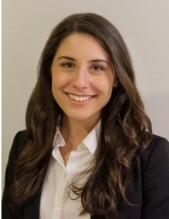In the News
Congratulations & Welcome to our new residents for the Fall of 2020
Luis H. Quiroga, MD, MPH
We are very excited to announce Luis H. Quiroga, MD, MPH as our new PGY-2 resident with the Division of Plastic, Reconstructive & Hand Surgery.

Dr. Quiroga has completed 4 years of General Surgery training and is in the process of wrapping up his post-doctoral clinical research fellowship at Johns Hopkins University School of Medicine in Baltimore, MD.
Kristen Hardy, MD
We are very excited to announce Kristen Hardy as our new PGY-1 resident with the Division of Plastic, Reconstructive & Hand Surgery.

Kristen will be a graduate of West Virginia University School of Medicine – Charleston in Charleston, WV in May 2020.
-------------------------------------------------------------------------------------------------------------------------------------
Surgeons at WVU Medicine have performed the state’s first target muscle reinnervation (TMR) procedure, a technique that transfers residual nerves from an amputated limb into new muscle, allowing patients to control new bioelectric prosthetics.
“TMR allows us to use muscles that no longer function due to the amputation of a limb and reconnect them with existing nerves to create a bioelectric signal to flex the arm or squeeze the hand of a prosthetic,” Jack Gelman, MD, WVU Medicine plastic surgery associate program director, said. “This makes the use of prosthetics very intuitive, because the same nerves that were used to operate the patient’s arm are being used to operate the prosthesis.”
In addition to allowing patients to use more functional prosthetics, targeted muscle reinnervation can be used to treat pain from phantom limb and neuromas, a painful formation of scar tissue at the end of a nerve. By creating a pathway for the nerves in the reinnervated muscle, it is less likely that they will develop painful scar tissue, a common problem for patients who have had amputations.
“This procedure requires a multidisciplinary approach,” Dr. Gelman said. “We are working with physical and occupational therapists, prosthetists, orthopaedic surgeons, neurosurgeons, and other specialists to make this possible for our patients.”
The procedure can be performed either during the original amputation or at a later time, in order to improve functionality and reduce pain.
“This technology is evolving and getting better,” Gelman said. “We are able to provide patients with prosthetics that look and move more like natural limbs, allowing for better grip in hands and a more natural stride when walking.”
According to Gelman, researchers are developing prosthetics that not only restore functionality but allow the patient to feel. These prosthetics will relay nerve signals either through electrodes or wireless technology.
“The field of myoelectric prosthesis control is constantly developing,” Gelman said. “Targeted muscle reinnervation can allow us to improve the quality of life for these patients, not only through the use of these new prosthetics, but by alleviating the pain they experience.”
-------------------------------------------------------------------------------------------------------------------------------------
Dr. Christiane Ueno recently developed four videos regarding Breast Reconstruction
https://wvumedicine.org/cancer/cancer-services/breast-cancer/reconstruction/
-------------------------------------------------------------------------------------------------------------------------------------
recently developed four videos
WVU Medicine Children’s establishes Pediatric Craniofacial Center
Wednesday, July 5, 2017
MORGANTOWN, W.Va. – WVU Medicine Children’s has established a Pediatric Craniofacial Center to deliver care to children with cleft lip/palate and other craniofacial anomalies in West Virginia and the surrounding region.
 Aaron Mason, M.D.
Aaron Mason, M.D.
The Center, under the direction of pediatric plastic and craniofacial surgeon Aaron Mason, M.D., manages patients with traumatic and congenital craniofacial abnormalities and includes five programs – the Cleft Lip and Palate Program, the Craniofacial Program, the Vascular Anomalies Program, the Infant Airway Program, and the Craniofacial Trauma Program.
The goal of the team is to provide focused, state-of-the-art care by several subspecialists, including but not limited to plastic surgery, oral and maxillofacial surgery, dentistry, neurosurgery, otolaryngology, genetics, audiology, psychological counseling, speech therapy, and social work.
Experts in the Cleft Lip and Palate Program repair cleft lips and palates and manage resulting and related complications, including velopharyngeal insufficiency (VPI), which occurs when the body cannot close the communication between the nasal cavity and the mouth; dental problems; and ear and hearing problems.
The Craniofacial Program treats infants and children with craniosynostosis, the premature closing of the fibrous joints between the bones of the skull; oculoauricular verterbral spectrum, which includes malformations of the eyes, ears, and spine; microtia, underdevelopment of the external part of the ear; acquired posterior plagiocephaly, a flat spot on the back or side of the head; and other rare conditions.
Providers in the Vascular Anomalies Program treat hemangiomas, benign tumors that appear as red birthmarks, and capillary, lymphatic, and venous malformations.
The Infant Airway Program treats conditions that cause obstruction of the airway, including Pierre Robin Syndrome, a collection of head and facial abnormalities, and mandibular hypoplasia, an incomplete or under-formation of the lower jaw.
Members of the Craniofacial Trauma Program treat craniofacial fractures and other related trauma-induced facial concerns.
“We are excited to be able to provide West Virginia with comprehensive, multidisciplinary pediatric care for these conditions,” Dr. Mason said. “Patients used to need to leave the state for this level of care, now they can remain in state, closer to home.”
For more information: Angela Jones-Knopf, Manager of Media Relations, 304-293-1413